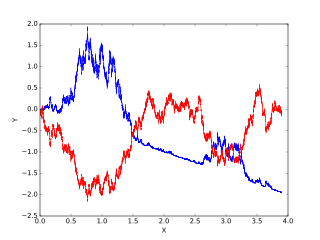
In mathematics, the Wiener process is a real-valued continuous-time stochastic process named in honor of American mathematician Norbert Wiener for his investigations on the mathematical properties of the one-dimensional Brownian motion. It is often also called Brownian motion due to its historical connection with the physical process of the same name originally observed by Scottish botanist Robert Brown. It is one of the best known Lévy processes and occurs frequently in pure and applied mathematics, economics, quantitative finance, evolutionary biology, and physics.

Stochastic calculus is a branch of mathematics that operates on stochastic processes. It allows a consistent theory of integration to be defined for integrals of stochastic processes with respect to stochastic processes. This field was created and started by the Japanese mathematician Kiyosi Itô during World War II.

In probability theory, the Girsanov theorem tells how stochastic processes change under changes in measure. The theorem is especially important in the theory of financial mathematics as it tells how to convert from the physical measure which describes the probability that an underlying instrument will take a particular value or values to the risk-neutral measure which is a very useful tool for evaluating the value of derivatives on the underlying.
In probability theory, a Lévy process, named after the French mathematician Paul Lévy, is a stochastic process with independent, stationary increments: it represents the motion of a point whose successive displacements are random, in which displacements in pairwise disjoint time intervals are independent, and displacements in different time intervals of the same length have identical probability distributions. A Lévy process may thus be viewed as the continuous-time analog of a random walk.
A stochastic differential equation (SDE) is a differential equation in which one or more of the terms is a stochastic process, resulting in a solution which is also a stochastic process. SDEs have many applications throughout pure mathematics and are used to model various behaviours of stochastic models such as stock prices, random growth models or physical systems that are subjected to thermal fluctuations.

Itô calculus, named after Kiyosi Itô, extends the methods of calculus to stochastic processes such as Brownian motion. It has important applications in mathematical finance and stochastic differential equations.
In mathematics, quadratic variation is used in the analysis of stochastic processes such as Brownian motion and other martingales. Quadratic variation is just one kind of variation of a process.
In mathematics, a stopped process is a stochastic process that is forced to assume the same value after a prescribed time.
In mathematical analysis, the Russo–Vallois integral is an extension to stochastic processes of the classical Riemann–Stieltjes integral
In probability theory, a real valued stochastic process X is called a semimartingale if it can be decomposed as the sum of a local martingale and a càdlàg adapted finite-variation process. Semimartingales are "good integrators", forming the largest class of processes with respect to which the Itô integral and the Stratonovich integral can be defined.
In the stochastic calculus, Tanaka's formula for the Brownian motion states that
In mathematics – specifically, in stochastic analysis – an Itô diffusion is a solution to a specific type of stochastic differential equation. That equation is similar to the Langevin equation used in physics to describe the Brownian motion of a particle subjected to a potential in a viscous fluid. Itô diffusions are named after the Japanese mathematician Kiyosi Itô.
In mathematics — specifically, in stochastic analysis — the Green measure is a measure associated to an Itō diffusion. There is an associated Green formula representing suitably smooth functions in terms of the Green measure and first exit times of the diffusion. The concepts are named after the British mathematician George Green and are generalizations of the classical Green's function and Green formula to the stochastic case using Dynkin's formula.
In mathematics — specifically, in stochastic analysis — the infinitesimal generator of a Feller process is a Fourier multiplier operator that encodes a great deal of information about the process.
In mathematics, Schilder's theorem is a generalization of the Laplace method from integrals on to functional Wiener integration. The theorem is used in the large deviations theory of stochastic processes. Roughly speaking, out of Schilder's theorem one gets an estimate for the probability that a (scaled-down) sample path of Brownian motion will stray far from the mean path. This statement is made precise using rate functions. Schilder's theorem is generalized by the Freidlin–Wentzell theorem for Itō diffusions.
In mathematics, the Freidlin–Wentzell theorem is a result in the large deviations theory of stochastic processes. Roughly speaking, the Freidlin–Wentzell theorem gives an estimate for the probability that a (scaled-down) sample path of an Itō diffusion will stray far from the mean path. This statement is made precise using rate functions. The Freidlin–Wentzell theorem generalizes Schilder's theorem for standard Brownian motion.
In stochastic calculus, the Doléans-Dade exponential or stochastic exponential of a semimartingale X is the unique strong solution of the stochastic differential equation
In stochastic analysis, a rough path is a generalization of the notion of smooth path allowing to construct a robust solution theory for controlled differential equations driven by classically irregular signals, for example a Wiener process. The theory was developed in the 1990s by Terry Lyons. Several accounts of the theory are available.
The Engelbert–Schmidt zero–one law is a theorem that gives a mathematical criterion for an event associated with a continuous, non-decreasing additive functional of Brownian motion to have probability either 0 or 1, without the possibility of an intermediate value. This zero-one law is used in the study of questions of finiteness and asymptotic behavior for stochastic differential equations. This 0-1 law, published in 1981, is named after Hans-Jürgen Engelbert and the probabilist Wolfgang Schmidt.
In mathematics, stochastic analysis on manifolds or stochastic differential geometry is the study of stochastic analysis over smooth manifolds. It is therefore a synthesis of stochastic analysis and differential geometry.








































